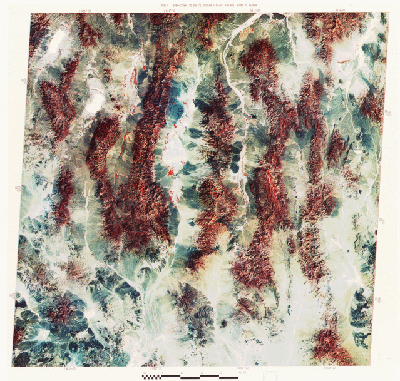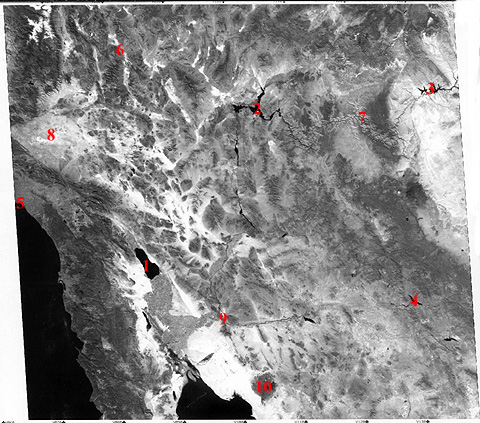

central Nevada. Major C.E. Dutton, an early explorer of the American West, described these mountains as they appeared on a map as resembling "an army of caterpillars crawling northward out of Mexico". Such characteristic topography results from a complex structural history dominated by block faulting (somewhat like the faulting we encountered in Kenya in Section 3). The region as it underwent tensional stresses during uplift of the crust responded by fracturing that trends largely N-S along which segments dropped down (faulted) leaving adjacent range blocks higher (present elevations can be greater than 2700 m [9000 ft], producing relief of 900 to 1520 m [3000 to 5000 ft] relative to the basins). The five major ranges in this scene are (left to right) the Shoshone, Toyabe, Toquima, Monitor, and Hot Creek Mountains; higher slopes are forested, as suggested by the reds in this September scene.
The intermontane basins between ranges have been back-filled with great amounts of rock debris descending downslope, so that the valley floors are moving upwards as the ranges are worn down. The central (lowest) surfaces of some of the basins contain playas, deposits of fine sediment left after intermittent lakes evaporate following the rainy season, that are light-toned in the image. Between playas and ranges, along the transitional zone known as a piedmont (literally, "foot of the mountain"), are deposits of coarser sediment (up to cobbles and boulders in size) mixed with clays that make up alluvial fans (dark gray in the image). Dry stream beds are also evident in the scene. Patches of red , especially in the central Big Smoky Valley, indicate local grasses and small farms that take advantage of moisture left over from flow along intermittent streams (dry at this time). Tonapah and Warm Springs are the only towns located in this image. Note the dark basaltic lava flows just above the lower right corner.
By now, you have gained experience with picking out features in the landscape at scales represented by Landsat imagery. Before finishing our trip, we want to challenge you to apply this experience by locating or identifying geographic and geologic landmarks in a space image somewhat to the south of the main flight line. This image is much smaller in scale, covering about 1100 km (700 miles) on a side. Make this a game of finding the places listed below. Look over the black and white Day-Vis HCMM image that embraces much of the southwestern U.S. (part of southern California and Nevada, most of Arizona, a bit of Utah and small segments of the Mexican states of Baja California and Sonora) including some of the Basin and Range.

Use a U.S or World Atlas to aid in correlating landmarks in the scene with mapped features. To help you get oriented, the red numbers 1, 2, 3, are the Salton Sea, Lake Mead, and Lake Powell, respectively. Pin these down on an atlas to give you a feel for the scale. Then, relying on the maps, identify what is at or around the numbers 4, 5, 6, 7, 8, 9, and 10. (Answers below). Finally, without the aid of number guides, try to find the Gulf of California, San Diego, the Imperial Valley, the Sierra Nevada, Las Vegas, Phoenix, and Tucson. Also, what is the name of the great geologic fault that marks (as a straight tonal boundary) the southern edge of the Mojave Valley?
Code 935, Goddard Space Flight Center, NASA
Written by: Nicholas M. Short, Sr. email: nmshort@epix.net
and
Jon Robinson email: Jon.W.Robinson.1@gsfc.nasa.gov
Webmaster: Bill Dickinson Jr. email: rstwebmaster@gsti.com
Web Production: Christiane Robinson, Terri Ho and Nannette Fekete
Updated: 1999.03.15.